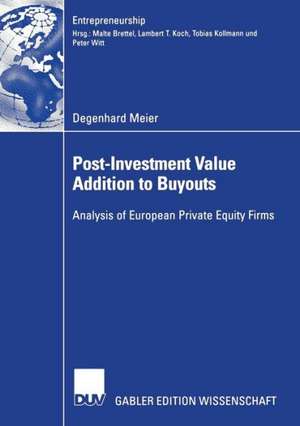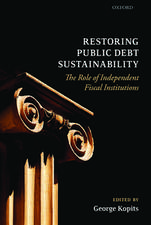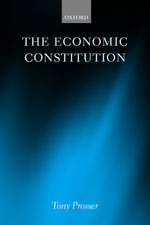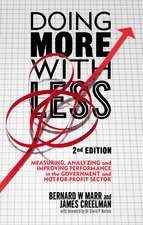Post-Investment Value Addition to Buyouts: Analysis of European Private Equity Firms: Entrepreneurship
Autor Degenhard Meier Cuvânt înainte de Prof. Dr. Malte Brettelen Limba Engleză Paperback – 24 feb 2006
Din seria Entrepreneurship
- 5%
 Preț: 81.87 lei
Preț: 81.87 lei - 6%
 Preț: 104.04 lei
Preț: 104.04 lei -
 Preț: 485.24 lei
Preț: 485.24 lei -
 Preț: 386.81 lei
Preț: 386.81 lei -
 Preț: 450.49 lei
Preț: 450.49 lei - 15%
 Preț: 439.56 lei
Preț: 439.56 lei - 15%
 Preț: 437.25 lei
Preț: 437.25 lei - 15%
 Preț: 441.51 lei
Preț: 441.51 lei - 15%
 Preț: 442.48 lei
Preț: 442.48 lei -
 Preț: 486.60 lei
Preț: 486.60 lei -
 Preț: 489.48 lei
Preț: 489.48 lei - 15%
 Preț: 645.47 lei
Preț: 645.47 lei - 15%
 Preț: 469.91 lei
Preț: 469.91 lei - 15%
 Preț: 504.02 lei
Preț: 504.02 lei - 15%
 Preț: 525.01 lei
Preț: 525.01 lei - 15%
 Preț: 437.76 lei
Preț: 437.76 lei - 15%
 Preț: 441.33 lei
Preț: 441.33 lei -
 Preț: 453.21 lei
Preț: 453.21 lei - 15%
 Preț: 444.61 lei
Preț: 444.61 lei - 15%
 Preț: 441.19 lei
Preț: 441.19 lei -
 Preț: 485.46 lei
Preț: 485.46 lei -
 Preț: 386.99 lei
Preț: 386.99 lei -
 Preț: 391.99 lei
Preț: 391.99 lei - 15%
 Preț: 445.76 lei
Preț: 445.76 lei -
 Preț: 386.00 lei
Preț: 386.00 lei -
 Preț: 485.99 lei
Preț: 485.99 lei -
 Preț: 388.34 lei
Preț: 388.34 lei -
 Preț: 382.36 lei
Preț: 382.36 lei - 15%
 Preț: 440.54 lei
Preț: 440.54 lei -
 Preț: 486.21 lei
Preț: 486.21 lei - 15%
 Preț: 442.82 lei
Preț: 442.82 lei -
 Preț: 486.21 lei
Preț: 486.21 lei -
 Preț: 486.42 lei
Preț: 486.42 lei - 15%
 Preț: 440.35 lei
Preț: 440.35 lei - 15%
 Preț: 445.26 lei
Preț: 445.26 lei - 15%
 Preț: 476.94 lei
Preț: 476.94 lei - 15%
 Preț: 530.94 lei
Preț: 530.94 lei - 15%
 Preț: 534.36 lei
Preț: 534.36 lei - 15%
 Preț: 439.56 lei
Preț: 439.56 lei - 15%
 Preț: 440.54 lei
Preț: 440.54 lei -
 Preț: 452.03 lei
Preț: 452.03 lei -
 Preț: 454.16 lei
Preț: 454.16 lei -
 Preț: 418.29 lei
Preț: 418.29 lei - 15%
 Preț: 446.27 lei
Preț: 446.27 lei -
 Preț: 384.86 lei
Preț: 384.86 lei -
 Preț: 386.22 lei
Preț: 386.22 lei - 15%
 Preț: 445.26 lei
Preț: 445.26 lei -
 Preț: 481.20 lei
Preț: 481.20 lei - 15%
 Preț: 444.61 lei
Preț: 444.61 lei - 15%
 Preț: 473.81 lei
Preț: 473.81 lei
Preț: 380.63 lei
Nou
Puncte Express: 571
Preț estimativ în valută:
72.83€ • 76.05$ • 60.14£
72.83€ • 76.05$ • 60.14£
Carte tipărită la comandă
Livrare economică 15-29 aprilie
Preluare comenzi: 021 569.72.76
Specificații
ISBN-13: 9783835002289
ISBN-10: 3835002287
Pagini: 174
Ilustrații: XV, 159 p.
Dimensiuni: 148 x 210 x 9 mm
Greutate: 0.24 kg
Ediția:2006
Editura: Deutscher Universitätsverlag
Colecția Deutscher Universitätsverlag
Seria Entrepreneurship
Locul publicării:Wiesbaden, Germany
ISBN-10: 3835002287
Pagini: 174
Ilustrații: XV, 159 p.
Dimensiuni: 148 x 210 x 9 mm
Greutate: 0.24 kg
Ediția:2006
Editura: Deutscher Universitätsverlag
Colecția Deutscher Universitätsverlag
Seria Entrepreneurship
Locul publicării:Wiesbaden, Germany
Public țintă
ResearchCuprins
Framework for structuring the analysis of post-investment value addition to buyoutsMethodology of data analysisDerivation of hypothesis and design of the survey instrumentData collection and analysisInterpretation of the results and implications for practitioners
Notă biografică
Dr. Degenhard Meier promovierte bei Prof. Dr. Malte Brettel am Lehrstuhl für Wirtschaftswissenschaften für Ingenieure und Naturwissenschaftler der RWTH Aachen. Er ist als Consultant für Bain & Company in München tätig.
Textul de pe ultima copertă
From 1999 onwards, the performance of buyout investments in Europe has steadily declined. As the traditional levers of value creation - high financial leverage and multiple expansion - are common knowledge in the private equity industry and therefore no longer a source of competitive advantage, the future success of buyout investments in Europe will depend on the ability of private equity firms to improve the operating performance of their portfolio companies post-acquisition.
Degenhard Meier identifies the success factors of post-investment value creation and their relative importance. He explores the dimensions of post-investment value addition characterizing the interaction between private equity firms and their portfolio companies and derives plausible hypotheses which he tests in an innovative way, i.e. he takes the current discussion on alternative methods to structural equation modeling as a basis and develops this discussion further by shedding light on partial least squares - a variance-based approach to structural equation modeling.
Degenhard Meier identifies the success factors of post-investment value creation and their relative importance. He explores the dimensions of post-investment value addition characterizing the interaction between private equity firms and their portfolio companies and derives plausible hypotheses which he tests in an innovative way, i.e. he takes the current discussion on alternative methods to structural equation modeling as a basis and develops this discussion further by shedding light on partial least squares - a variance-based approach to structural equation modeling.














